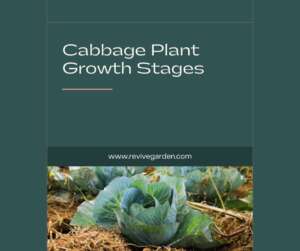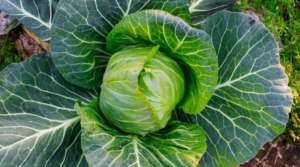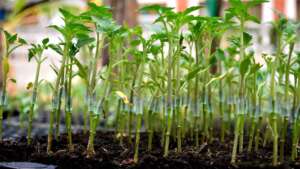Table of Contents

This article will show you what you should do to grow cabbage plants fast in your garden. There are a lot of people who are not familiar with cabbage plant growth stages, as they are not generally involved in routine gardening activities. The average farmer is only aware of the fact that cabbage plants will grow to maturity depending on the temperature, amount of water and soil nutrients.
Cabbage plants go through certain stages of growth, and each stage is a little bit different. In this article, we’ll be covering all the various plant growth stages of cabbage. And, in the end, we’ll also give you some proof of how cabbage plants grow.
Cabbage Plant Growth Stages – That Most People Don’t Know About

Cabbage plants are very easy to grow. They are a member of the cruciferous family that includes broccoli, cauliflower, mustard, etc. They are a relative of such common garden plants as collards and kale. They’re also known as “White Cabbage” and come from the same plant species as Brussels sprouts, kale, and cauliflower. We are exploring all the stages of cabbage plant growth.
The Philosophy of choosing Cabbage Growth Stages
The most noticeable differences between cabbage plants that are growing in stages are the different shapes and sizes. There is considerable growth from any stage to the other, and it’s usually measurable. It’s vital to understand that cabbage plants are living organisms and as such you can’t expect predictable growth stages or growth speed. There is a good reason why cabbage is a top-10 model for organic gardening. It’s rich in antioxidants and vitamins, extremely adaptable to different climates, and almost undemanding your attention throughout the growth cycle. How can you help the cabbage reach its maximum potential? Read on to learn all about the germination, transplantation, and growth stages of cabbage.
Key points of Cabbage plant growth stages
- · Root growth, about two weeks after planting.
- Transplanting, about one month after planting, if not planted directly into the ground.
- Leaf development, five to six weeks after planting.
- Full head growth, three to four months after planting.
- Cabbage plants have many stages of growth until harvest.
In Detail Once and For All
Prepare the Soil
Cabbage is a heavy feeder and will require good soil with plenty of organic matter. If you are starting from seed, prepare the soil by adding compost or aged manure. You can also add some aged animal bedding. This will give your cabbage plants plenty of nutrients as they grow. The soil must be well-drained, so it doesn’t get too soggy when it rains.
Vegetative Growth

During this stage of growth, your cabbage plants will continue to grow and produce leaves as well as flower buds if they are not being eaten by pests such as aphids or cutworms. The leaves may start curling up during this time if they are not getting enough water or nutrients from the soil. If this happens, add more fertilizer to your soil mix before transplanting your cabbage plants into it so they have plenty of energy for growing strong roots.
Root growth, about two weeks after planting.
You can start cabbage seeds indoors or outdoors depending on your location and weather. In warm climates and during the summer, it’s best to start them indoors. However, if you live in a cooler climate, you may have better luck starting them outside.
To germinate cabbage seeds, place them in a flat with a light covering of soil. Press down lightly on the soil to ensure good contact between seeds and soil and then water thoroughly until water drains from the bottom of the flat. Leave the flats out of direct sunlight for about two weeks until germination occurs. After two weeks move flats into indirect sunlight for another two weeks before transplanting them into larger containers or directly into the ground as described below.
Blooming stage
This stage lasts for about 5 days after flowering begins.
Bolting stage
Bolting is the term used when plants produce seed heads instead of forming heads of fruit or vegetables. With cabbage, bolting starts when flowers begin blooming on the plant.
Fruiting stage
Fruiting is the stage where leaves are formed into heads of cabbage, cauliflower or broccoli.
Transplanting, about one month after planting, if not planted directly into the ground.
If your cabbage was started indoors it will need to be transplanted into the garden when it is approximately 3 inches tall (7 cm) with at least two sets of true leaves (these are leaves that have not yet formed ahead). The pot should be slightly larger than the seedling so that it doesn’t become root-bound. Use a dibble stick or small shovel to loosen up the soil around your transplant location before lifting out the pot so as not to damage any roots that may still be attached to the soil on their way out of the pot.
- transplanting should be done when the plant is about one month old
- transplanting should be done if the plants were not planted directly into the ground
- transplanting should be done if the plant is not doing well in its current location
- transplanting should be done if the plant is too crowded
Leaf development, five to six weeks after planting.
- leaves are a good indicator of plant health
- leaves should be a dark green colour
- leaves should be smooth and not wrinkled
- leaves should be flat, not curled
- leaves should be about the same size
- leaves should be about the same distance apart
Full head growth, three to four months after planting.
- cabbages take a long time to grow
- cabbages are ready to harvest when they are fully grown
- cabbages are ready for harvest when the heads are firm
- cabbages are ready for harvest when the leaves are brown
Cabbage plants have many stages of growth until harvest.
- cabbage plants take about 3 months to grow
- cabbage plants are ready to harvest at about 4 months
- if you want to extend the growing season, you can plant in the fall
- if you want to extend the growing season, you can plant in the spring
Final words
We have gone throw all possible cabbage plant growth stages. We have also discussed the philosophy of cabbage and its family. You may find the key points of the growth stages of the cabbage plant. If you feel any queries regarding this article, we will appreciate your comments with a positive response.
